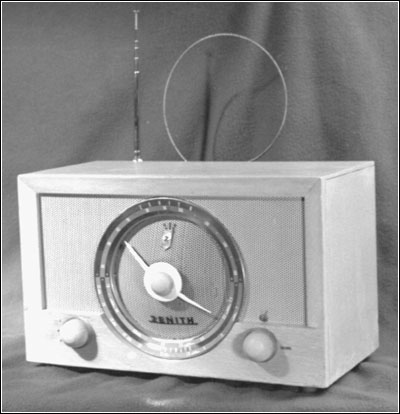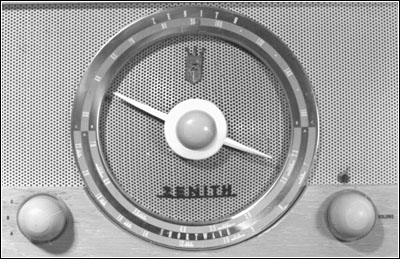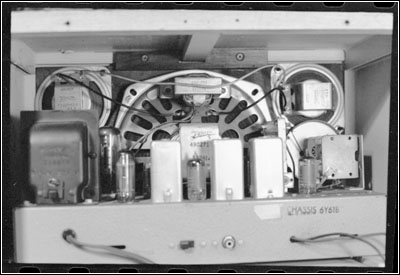Of Old Radios And Related Items--Published Monthly
Zenith 6Y61B Tabletop Shortwave
BY ANDREW HAYDEN
Web Edition
Once in a while, you pass on an interesting set and then have a chance to go back and reconsider. Andrew Hayden describes that experience with a Zenith shortwave that has a bit of mystery about it that others may be able to help solve. (Editor)
When people think of Zenith shortwave, they think of the Trans-Oceanic which is known the world over as one of the best shortwave portables ever made. Starting with its introduction just prior to World War II and concluding with a transistorized version in the early 1980s, it remains a favorite with collectors today.
Tabletop shortwave radios were very popular in the 1930s and 1940s, but were not nearly as common in the 1950s since FM was gaining popularity. For those who specifically wanted to listen to distant stations, a portable SW radio or a real communications receiver, such as a Collins or a Hallicrafters, would have been the choice.
In recent years, I have developed an interest in the 8-tube AM/FM Zeniths of the 1950s and early 1960s because of their superb sound quality. As a result, I am very familiar with the 1955 top-of-the-line Zenith "Super-Symphonaire," the Model Y832 AM/FM high fidelity radio. It is a real pleasure to listen to thanks to its 8-inch main speaker and a pair of electrostatic tweeters housed in a very solidly constructed wooden cabinet. Many consider this radio and its descendants to be among the best sounding AM/FM radios produced in the late tube era.
Figure 1. The Zenith tabletop shortwave receiver.Acquiring the Model 6Y61B
Recently, I spotted what I thought was a Model Y832 with both a telescopic and a loop antenna mounted on its back panel sitting on the floor of an indoor antique market. See Figure 1. Having that 1950s cold war look, the set with its blond cabinet finish and large circular dial did stand out against its surroundings. Since I had a Y832 at home and the asking price was a bit high on this one, I passed.
Over the course of the next eight months I would glance down at it every time I checked for new inventory at this market. Maybe I should have noticed another oddity in its appearance -- a white enamel dial pointer. All the other large Zeniths from the 1950s had a gold electroplate finished pointer.
No one seemed to have any interest whatsoever in this radio, and the dust covering it was getting thick, so I decided to take a closer look. What's this -- it's not AM/FM -- it's AM plus shortwave and has six tubes not eight! Now I'm interested.
Figure 2. The markings across the top of the large dial are for the broadcast band. Along the bottom are the two shortwave bands. The right small knob is for volume; the left knob has two concentric knobs the outer is for tuning, the inner is the band switch.Since there was no model number to be found, I searched the internet with no results. I then corresponded with a few Zenith collectors. My first contact had seen one on a kitchen table when he was a child; another had also seen only one example in all his years of collecting Zeniths and thought it was a scarce model. Well that did it. I went down, took a chance and made an offer for half of the asking price and became the new owner for $30.
I was surprised that another radio collector hadn't grabbed this interesting Zenith. Besides the standard broadcast, it has two SW bands with its dial indicating 2.3 to 7 MHz; the second band is 7 to 22 MHz. See Figure 2. A label on the bottom of the cabinet listed four different chassis number possibilities: 6Y60T, 6Y61T -- 115 volts only; or 6Y60BT and 6Y61BT -- either 115 volts or 230 volts.
Chassis Revelations
When I removed the back cover, as shown in Figure 3, the chassis was marked 6Y61B (not BT). It operates on 115 volts and has a large transformer marked "115V-225V" with a switch for the desired voltage. This radio is not an AC/DC set like the other Zeniths of the era, and it has a tube line-up of the following types: one each 6BE6, 6X4, and 6AT6; two 6BA6s; and one 6K6GT output tube. Also to my surprise was the presence of two 3-inch cone tweeters flanking the large 8-inch center speaker instead of the electrostatic tweeters seen in the Model Y832.
This radio has "big" sound with both low and high frequencies being noticeably stronger than other radios from the 1950s, and it gives the expensive German sets a run for their money in terms of performance. It also has the unique tone adjustment knob in the center of the dial pointer, which was an interesting feature of the high end Zeniths. The combined speaker-dial arrangement itself had been patented by Zenith in 1942 and is seen on many models made through the late 1950s. Cabinet dimensions are a relatively modest 151/2" x 10" x 8" deep.
The consensus so far is that it's an export model, but I wonder if it was also offered in the U.S. considering that there was a 115-volt only version (chassis 6Y61T), and that an example had been seen in a home, as I mentioned earlier. I can see why this set would not have sold well with buyers, since the impressive Trans-Oceanic lay close by on the dealer's sales floor.
Figure 3. A rear inside view of the Zenith set. Note the two "tweeters" on each side of the larger main speaker. The text "Chassis 6Y61B" can be seen on the right/top of the chassis.On the topic of exports, there's a very interesting bit of information in Zenith's Annual Report for 1955. It reads, "A number of important foreign markets remain closed to Zenith merchandise through operation of a world cartel controlling patents and foreign trade in radio and television receivers." The report goes on to say that overall export sales declined in 1955 with sales to the Armed Forces declining sharply, while all other segments of the company saw marked growth. The full line of Zenith radios is discussed in the report, but there is no mention of a tabletop shortwave.
Another possibility regarding the history of the set is that it was brought to market early in 1956, sold poorly, and then discontinued. I would like to find out more about this seldom seen Zenith shortwave radio, so if any readers recognize it, or have further details, please let me know.
References:
Zenith Model Y832 Operating Guide - Zenith Corporation, 1955.
Zenith Annual Report for the Year 1955, Chicago: Zenith Radio Corporation.
U.S. Patent Number 2272660 Feb 10, 1942 -- Zenith Speaker-Dial combination.
Sound quality is an important element of Andrew Hayden's collecting interests. He is particularly interested in the history of electronics companies and has collected and researched vintage KLH electronics for over ten years.
|
[Free Sample] [Books, etc., For Sale] [Subscribe to A.R.C./Renew] [Classified Ads] [Auction Prices] [Event Calendar] [Links] [Home] [Issue Archives] [Book Reviews] [Subscription Information] [A.R.C. FAQ]URL = http://www.antiqueradio.com/Sep08_Hayden_Zenith.html Copyright © 1996-2008 by John V. Terrey - For personal use only. Last revised: August 25, 2008. For Customer Assistance please contact ARC@antiqueradio.com or call (866) 371-0512 toll free Antique Radio Classified |


